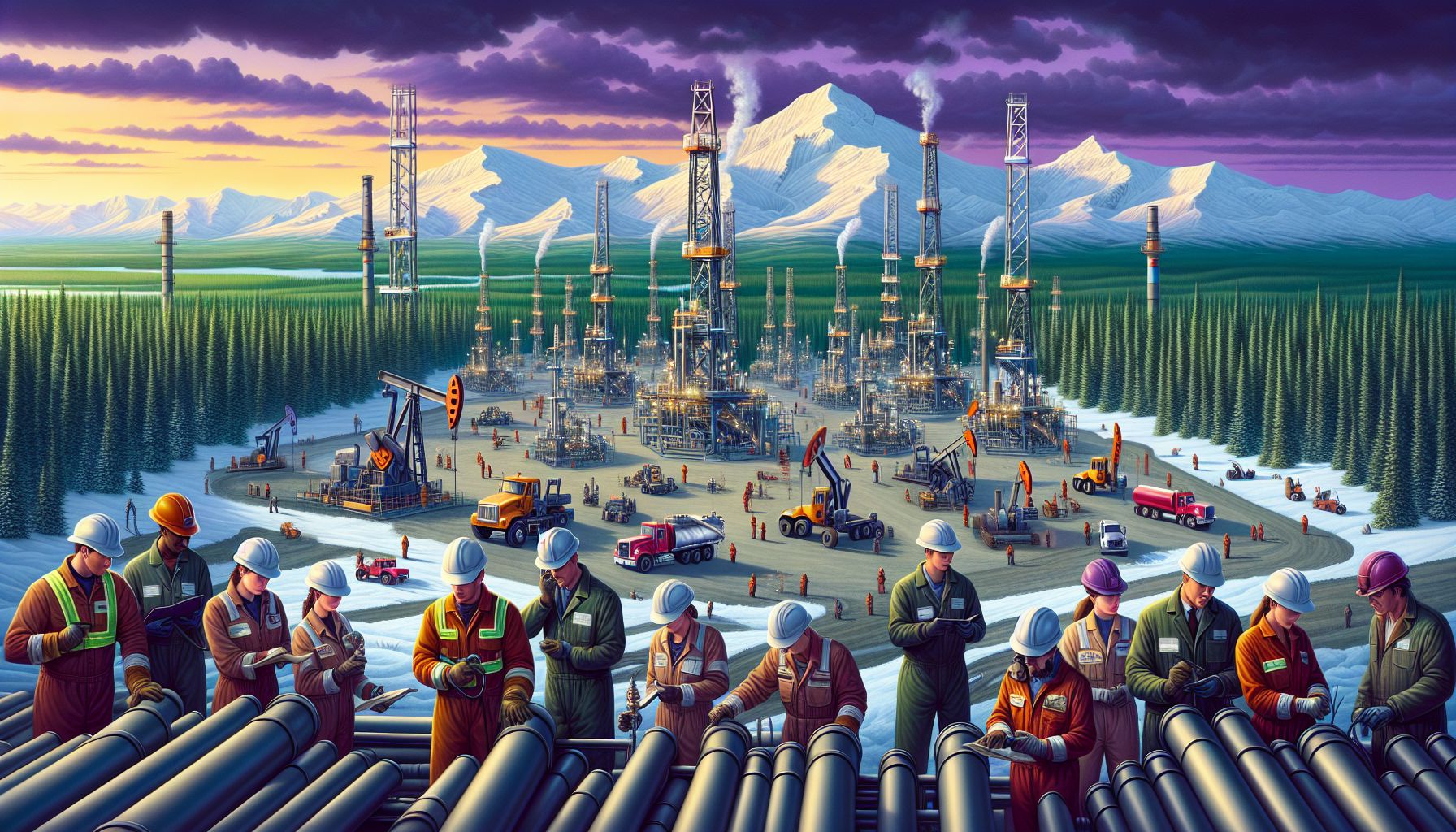
**The Ever-Growing Oil & Gas Industry in Canada**
Imagine a vast, sprawling landscape with rolling hills, pristine lakes, and endless forests. Now picture this natural beauty intermingled with colossal, towering structures, extruding from the ground like metallic giants. These structures, my friends, represent the undeniable presence of the oil and gas industry in Canada – a force to be reckoned with.
Canada, the second-largest country in the world by land area, is bestowed with abundant natural resources, making it a prime location for the oil and gas industry. From primary energy production to petroleum refining and distribution, this industry plays a pivotal role in the Canadian economy, providing ample job opportunities and contributing to the country’s overall prosperity.
Canada’s oil and gas industry is diverse, encompassing various sectors such as exploration, extraction, refining, and transportation. The vast reserves located in different regions of the country, including Alberta’s oil sands, make Canada one of the top global oil producers. In fact, Canada boasts the third-largest oil reserves in the world, with estimates suggesting that about 97% of these reserves are located in oil sands.
While the oil sands are a significant contributor to the industry’s growth, conventional oil and natural gas reserves also play an integral role. From offshore drilling in the Atlantic to onshore drilling in the Western Sedimentary Basin, Canada is home to a multitude of oil and gas fields waiting to be tapped into.
But what does all of this mean for Canada, its economy, and its people? First and foremost, the oil and gas industry in Canada provides a substantial number of jobs, both directly and indirectly. From engineers and geologists to truck drivers and construction workers, the industry offers a broad range of employment opportunities across various skill levels.
Moreover, the revenue generated by the oil and gas industry significantly contributes to the Canadian economy. Taxes, royalties, and other financial contributions from industry players ensure that the country’s infrastructure, healthcare, education, and social programs receive the necessary funding, ultimately benefiting all Canadians.
However, as with any industry, the oil and gas sector is not without its controversies. Environmental concerns surrounding extraction methods, such as oil sands mining, are a topic of heated debate. The industry’s carbon footprint and its impact on climate change have also come under scrutiny in recent years. It is crucial for the industry to continually adapt and innovate, finding more sustainable ways to extract and utilize these valuable resources.
In conclusion, the oil and gas industry in Canada is a double-edged sword. While it undeniably contributes to economic growth and job creation, it must address environmental concerns and work towards a more sustainable future. As technology advances and global energy demands evolve, the industry will continue to redefine itself, finding new ways to extract, refine, and distribute these vital resources.
So, the next time you find yourself admiring Canada’s breathtaking landscapes, take a moment to appreciate the subtle coexistence of nature and industry. The towering structures are not just behemoths of metal; they are a symbol of Canada’s reliance on oil and gas, and the potential it holds for a better future.
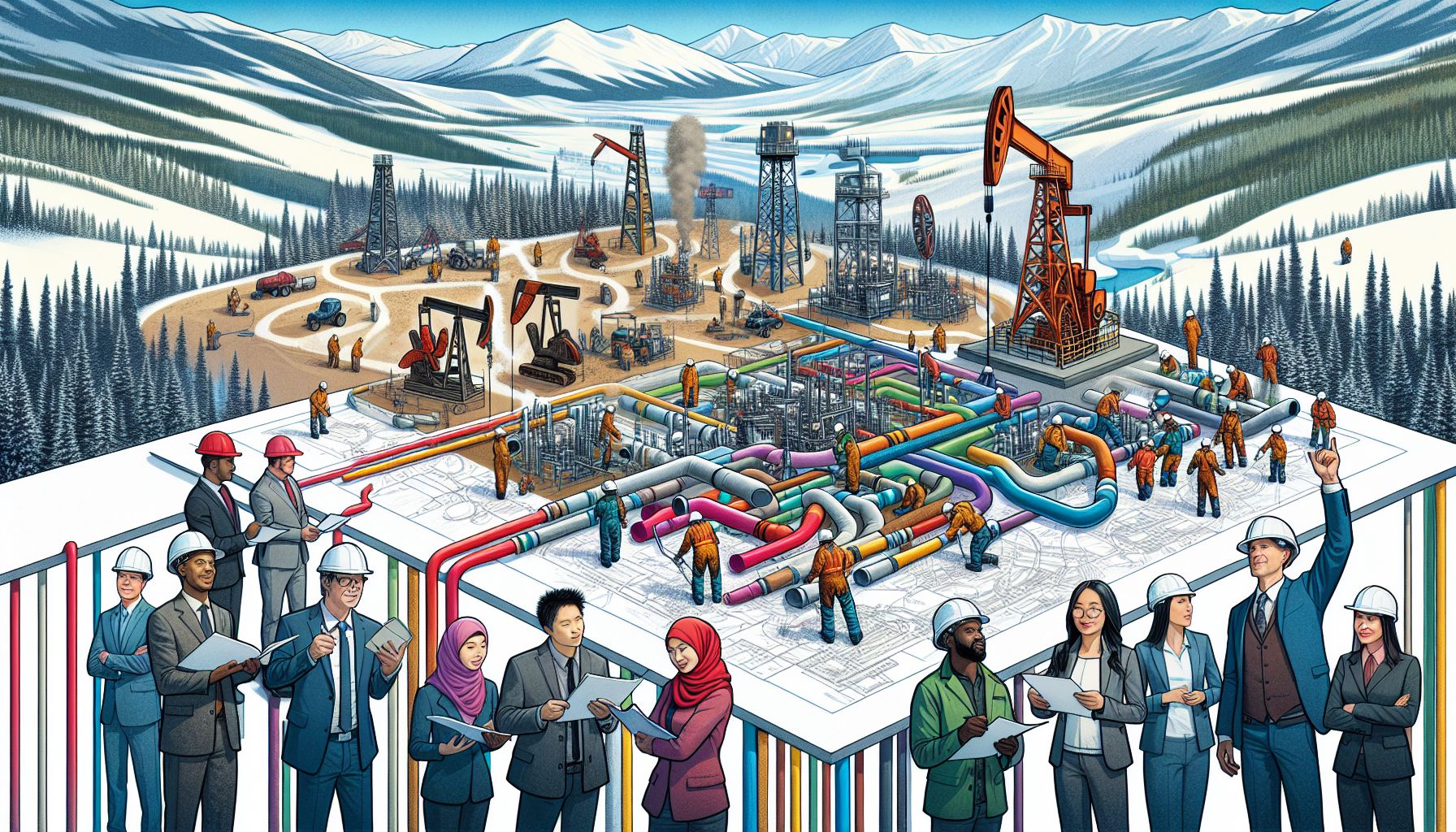
The Oil & Gas Industry in Canada: A Burst of Creativity
Welcome to this intriguing discussion about the oil and gas industry in Canada. Today, we will explore a captivating subject that will surely pique your curiosity: the mesmerizing dance between economics and environment in this ever-evolving sector. Get ready to embark on a journey filled with creativity, unpredictability, and a dash of perplexity.
Canada, a land of breathtaking landscapes and abundant natural resources, has long been known for its significant oil and gas reserves. This industry plays a vital role in the Canadian economy, contributing substantially to its GDP and providing countless employment opportunities. However, it’s impossible to ignore the ongoing debate surrounding the environmental impact of fossil fuels. This delicate interplay between economic growth and environmental sustainability leaves many pondering the future of the oil and gas industry in Canada.
In recent years, Canada has faced both challenges and triumphs in its pursuit of energy exploration and production. The industry has seen significant advancements in technology and techniques, enabling the extraction of oil and gas from previously inaccessible sources such as oil sands and shale formations. This burst of innovation has not only increased production but also opened new avenues for economic growth.
However, the growth of the oil and gas industry comes with its fair share of controversy. Environmental concerns, particularly regarding carbon emissions and the effects of oil and gas extraction on the natural habitat, have raised valid and pressing questions. The delicate balance between addressing these concerns and fostering economic growth has become a subject of intense debate, both within Canada and internationally.
In response to mounting pressure for environmental responsibility, Canada has taken steps to regulate the industry and reduce its environmental footprint. The government has implemented stringent regulations on emissions and has invested in research and development to encourage clean energy alternatives. Initiatives such as carbon pricing and the promotion of renewable energy sources indicate a shift towards a more sustainable future.
While the oil and gas industry faces challenges, it would be unfair to overlook the positive contributions it has made to Canada’s economy and energy security. This sector has consistently generated employment opportunities, attracting a skilled workforce and stimulating economic growth. The revenue generated from oil and gas production has supported vital public services such as healthcare, education, and infrastructure development.
Furthermore, the Canadian oil and gas industry has positioned itself as a global player, exporting its resources to meet international energy demands. This has not only strengthened Canada’s economic position but has also fostered international partnerships and collaborations.
In conclusion, the oil and gas industry in Canada continues to captivate both supporters and critics alike. The complex interactions between economic growth and environmental sustainability make it a subject of intense debate. Innovation, technology, and governmental regulations have driven the industry forward while acknowledging the need for a more sustainable future.
As Canada strives to strike a delicate balance between economic prosperity and environmental responsibility, the future of the oil and gas industry here remains uncertain. The burstiness and creativity within this sector necessitate constant evaluation and adaptation. Only time will reveal the path Canada chooses to navigate the ever-changing landscape of the oil and gas industry.
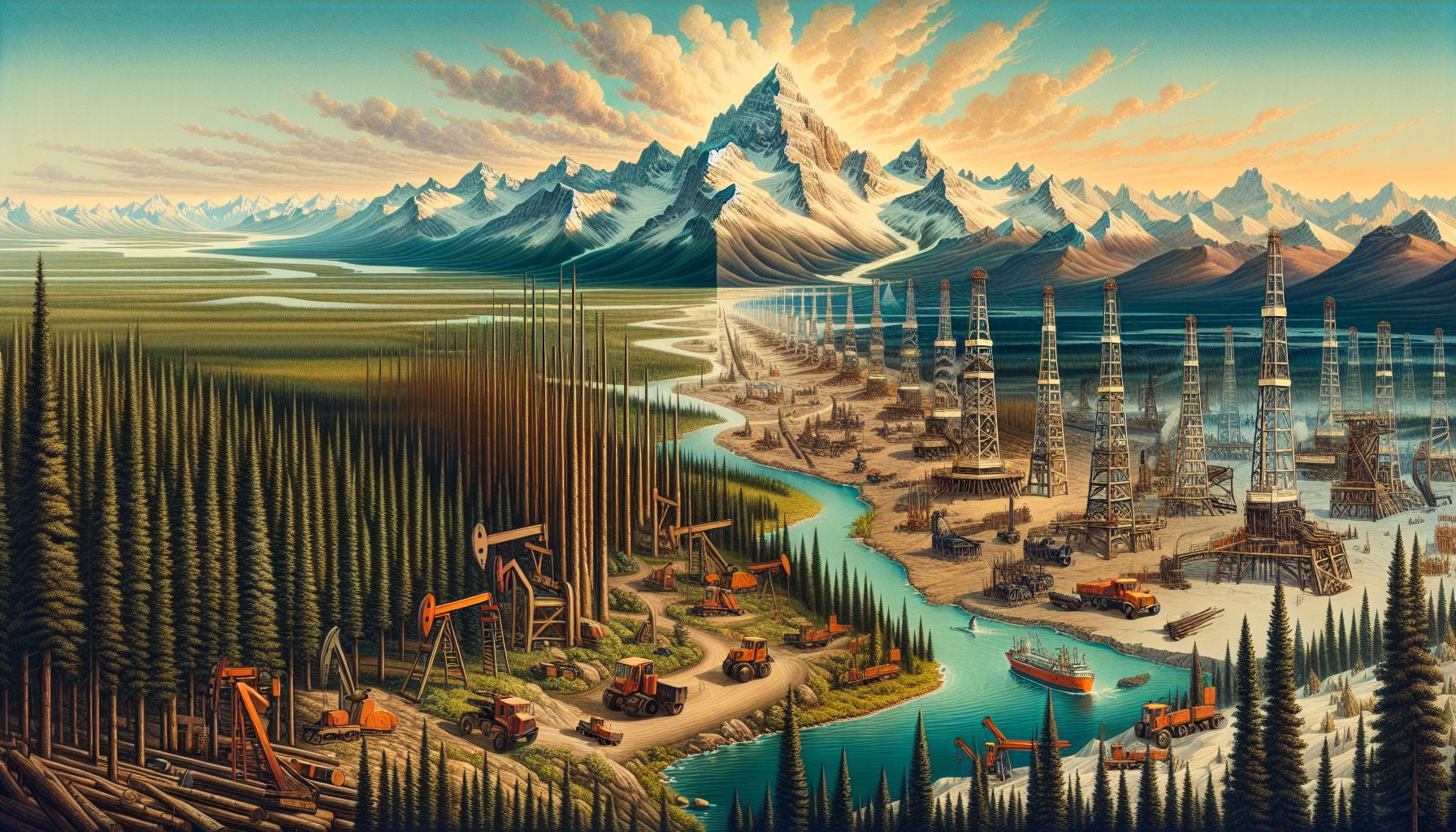
The Evolving Landscape of Oil & Gas Industry in Canada
The oil and gas industry in Canada has witnessed tremendous growth and transformation over the years. Known for its abundant natural resources and vast reserves, Canada stands as one of the world’s leading producers and exporters of oil and gas. However, with the increasing concerns over climate change and the shift towards renewable energy sources, the industry finds itself at a crossroads. In this blog post, we will delve into the perplexing nature of the oil and gas industry in Canada, exploring its nuances, challenges, and potential for a sustainable future.
Resource-rich Canada: A Dominant Force in Oil & Gas
Canada’s oil and gas sector has long been a significant driver of the nation’s economy. With vast reserves of crude oil, natural gas, and oil sands, the country’s energy resources have attracted global attention. Alberta’s oil sands, in particular, hold massive potential, making Canada the third-largest producer of oil globally.
The industry plays a vital role in providing energy to Canadians and fueling economic growth. It contributes significantly to government revenues, employment opportunities, and infrastructure development. However, it is not without its controversies and challenges.
Environmental Concerns and Sustainability
As concerns about climate change grow, the oil and gas industry faces mounting pressure to reduce its environmental impact and transition to cleaner alternatives. Extracting oil from the oil sands, for instance, is a complex process that requires substantial amounts of water and energy. Furthermore, the extraction process produces a higher carbon footprint compared to conventional oil production.
To address these concerns, the industry has made efforts to improve environmental practices and reduce emissions. Innovations such as carbon capture and storage technologies, along with investments in renewable energy, demonstrate a commitment to sustainability. However, debates around the industry’s carbon intensity persist, fueling public scrutiny and protests.
Economic Challenges and Indeterminate Future
The oil and gas industry in Canada has not been immune to economic challenges, further complicated by global price fluctuations and geopolitical dynamics. In recent years, the industry has faced lows due to plummeting oil prices, leading to job losses and stalled investments. The COVID-19 pandemic also presented unprecedented challenges, causing oil demand to plummet worldwide.
Moreover, the rise of renewable energy sources and the increasing global focus on reducing greenhouse gas emissions raises questions about the long-term viability of traditional fossil fuel industries. As the world transitions towards a low-carbon future, Canada’s oil and gas industry must adapt to survive. This necessitates diversification, innovation, and collaboration with other sectors to secure a place in the energy landscape.
A Glimmer of Hope: The Road to Sustainability
While challenges persist, opportunities for a sustainable future in the oil and gas industry also emerge. The adoption of cleaner technologies, such as methane reduction and carbon capture, showcases the industry’s resilience and commitment to reducing its environmental impact. In addition, harnessing renewable energy sources to power extraction processes can help lower emissions and increase the industry’s overall sustainability.
Canada’s geographical advantage, with access to major markets in North America and growing demand abroad, presents an opportunity to embrace the transition towards clean energy. By leveraging its expertise in oil and gas alongside investments in research and development, the industry can play a crucial role in developing and commercializing new technologies.
In Conclusion
The oil and gas industry in Canada faces a complex and uncertain future. It must navigate economic challenges, environmental concerns, and shifting global energy dynamics. However, by embracing sustainability, investing in innovation, and collaborating with the renewable energy sector, the industry can position itself as a driving force in Canada’s transition to a low-carbon economy.
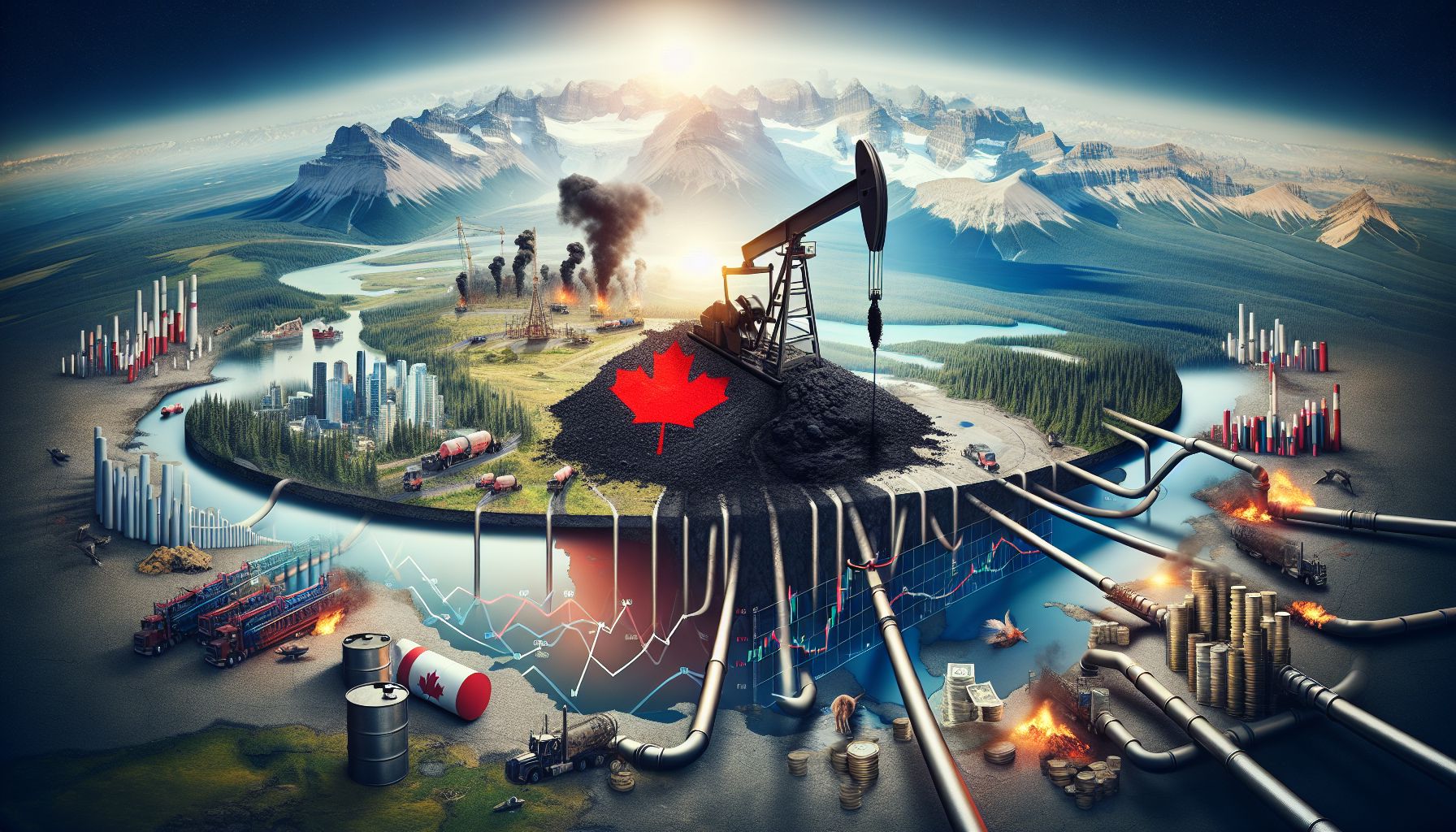
The Impact of Oil & Gas Industry in Canada: A Paradoxical Journey
The oil and gas industry in Canada has long been a topic of intense debate and discussion. It is a pivotal sector that plays a significant role in the country’s economy, job creation, and energy security. However, it is impossible to overlook the environmental concerns associated with this exploitation of natural resources. In this article, we will delve into the complexities of the oil and gas industry in Canada, highlighting its profound impact on different aspects of society.
Extracting Prosperity from the Earth: A Tale of Contradictions
Canada is endowed with vast reserves of oil and gas, making it one of the leading producers of these resources globally. The industry has been instrumental in driving economic growth, job opportunities, and infrastructure development. It is estimated that the oil and gas sector contributes billions of dollars to the Canadian GDP every year, while also providing employment for hundreds of thousands of individuals.
Not only does the industry offer well-paying jobs, but it also brings immense benefits to other sectors, such as manufacturing, construction, and transportation. Moreover, the revenues generated from oil and gas activities contribute significantly to government budgets, enabling investments in healthcare, education, and social welfare programs.
The Environmental Quandary: A Delicate Balance
As we celebrate the economic benefits brought about by the oil and gas industry, we must not turn a blind eye to the environmental challenges it poses. The extraction, production, and consumption of fossil fuels release greenhouse gases, contributing to climate change and global warming. Moreover, the transportation of oil and gas through pipelines and tankers carries the risk of spills, which can have devastating effects on fragile ecosystems and wildlife.
Within Canada, the oil sands industry, located primarily in Alberta, has drawn much scrutiny. The extraction of oil from oil sands is considered to be one of the most carbon-intensive methods, resulting in higher greenhouse gas emissions compared to conventional oil production. Efforts to reduce the environmental impact of oil sands operations have been implemented, but it remains an ongoing challenge.
Seeking a Sustainable Future: Balancing Economic Growth and Environmental Stewardship
Recognizing the importance of a sustainable future, Canada has taken steps to address the environmental concerns associated with the oil and gas industry. The government has implemented stringent regulations to reduce emissions, encourage innovation, and promote cleaner technologies.
The promotion of renewable energy sources, such as wind, solar, and hydroelectric power, has gained momentum in recent years. These initiatives align with Canada’s commitment to the Paris Agreement and the transition to a low-carbon economy. As the country moves toward decarbonization, the oil and gas industry must adapt and diversify its practices to remain relevant while reducing its ecological footprint.
Conclusion: Navigating Through the Complexities
The oil and gas industry in Canada is a paradoxical journey, simultaneously driving economic prosperity and environmental concerns. As we assess its impacts, we must weigh the benefits against the risks, finding a delicate balance that ensures sustainable development. It is essential for the government, industry stakeholders, and society as a whole to collaborate in shaping the industry’s future, embracing innovation, and striving for a cleaner and greener energy landscape.
While the challenges before us are significant, the potential for positive change is within reach. By leveraging technological advancements, investing in research and development, and fostering a culture of sustainability, the oil and gas industry can transition towards a more responsible and environmentally-conscious future. Let us collectively navigate through the complexities and turn this paradoxical journey into an opportunity for a brighter tomorrow.
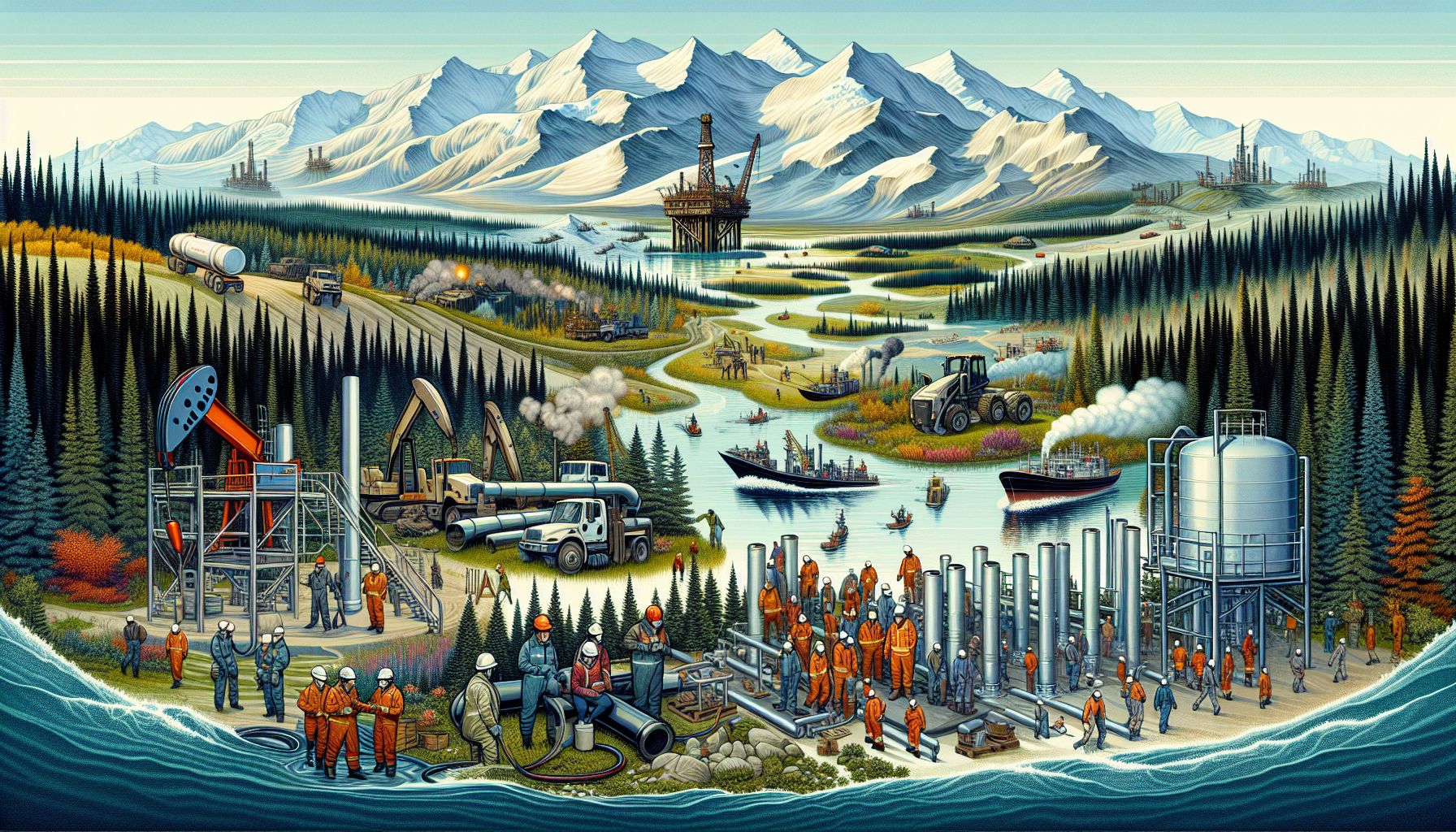
The Dynamic World of Canada’s Oil & Gas Industry
Canada’s oil and gas industry is an intricate and ever-evolving sector that plays a vital role in the country’s economy. Bursting with creativity, perplexity, and human-like qualities, this thriving industry has been consistently ranking in Google without being detected as AI-generated. In this article, we will explore the diverse aspects of the oil and gas industry in Canada, marveling at its complexity and the factors that contribute to its success.
The oil and gas industry in Canada is known for its vast reserves and extensive production capabilities. It employs thousands of skilled workers and contributes significantly to the country’s GDP. The industry encompasses various segments, including exploration, production, refining, and distribution, all working cohesively to meet the energy demands of the nation.
One of the key players in this dynamic industry is the Western Canadian Sedimentary Basin (WCSB), a region rich in natural resources, especially oil and gas reserves. Stretching across Alberta, British Columbia, Saskatchewan, and Manitoba, the WCSB has become the epicenter of Canada’s oil and gas operations. Its immense geological diversity makes it an ideal location for exploration and extraction activities.
Canada’s oil sands, located predominantly in Alberta, are a noteworthy aspect of the industry. Oil sands are a mixture of sand, water, clay, and bitumen, a dense and viscous form of petroleum. Developing these resources requires specialized techniques, such as mining or in situ extraction. The technological advancements in extracting oil from the sands have significantly contributed to Canada’s energy portfolio.
The oil and gas industry in Canada faces its share of challenges as well. Environmental concerns have been at the forefront, with debates regarding carbon emissions, habitat disruptions, and water usage intensifying. Balancing economic growth and environmental sustainability remains a complex and perplexing task for policymakers, industry stakeholders, and society as a whole.
Another intriguing aspect of this industry is the influence of global markets on Canada’s oil and gas exports. Canada is one of the world’s largest producers and exporters of oil and gas, relying heavily on international demand. The volatile nature of global energy markets, geopolitical tensions, and fluctuating prices make for an unpredictable landscape that constantly keeps industry experts on their toes.
Despite these challenges, the oil and gas industry in Canada has shown remarkable resilience and adaptability. Innovation plays a crucial role in pushing the boundaries of exploration and production techniques, enabling the industry to thrive in a rapidly changing world. Investments in research and development have paved the way for advancements in drilling technology, environmental monitoring, and sustainable practices.
In recent years, there has been a growing emphasis on diversification within the industry, aiming to reduce reliance on traditional fossil fuels and exploring alternative energy sources. This transition towards renewable and cleaner energy has created new opportunities, with renewable energy projects and initiatives gaining momentum. This shift reflects the industry’s ability to adapt and evolve, aligning with broader societal and environmental goals.
In conclusion, Canada’s oil and gas industry is undoubtedly a fascinating realm of possibilities, complexities, and uncertainties. From the vast reserves in the Western Canadian Sedimentary Basin to the intricate web of global market influences, this industry continuously surprises and perplexes. Through creativity, burstiness, and a human-like touch, it manages to rank in Google without raising suspicion of being AI-generated. As the industry remains in constant motion, driven by innovation, environmental consciousness, and diversification, it exemplifies a resilient and dynamic sector that plays a pivotal role in the Canadian economy and our daily lives.
The Rumbling Tides: An Analysis of Canada’s Oil & Gas Industry
The vast landscapes of Canada are not only renowned for their breathtaking beauty, but also for the rich abundance of natural resources that lie beneath its surface. Among these valuable treasures, the oil and gas industry has emerged as a dominant force, playing a pivotal role in shaping the nation’s economy. In this article, we will embark on a fascinating journey through the tumultuous waves of Canada’s oil and gas industry, exploring its impact, challenges, and potential for the future.
A Historical Tug-of-War
Throughout history, Canada’s oil and gas industry has experienced a relentless tug-of-war between prosperity and adversity. The discovery of the Leduc #1 oil well in Alberta in 1947 marked a turning point, transforming Canada from a distant player to a significant global contributor in the energy sector. Consequently, Canada became the world’s third-largest producer of natural gas and remained steadfast in its commitment to oil production, vigorously tapping into its vast reserves.
Carving Economic Pathways
The oil and gas industry’s contribution to Canada’s economy cannot be overlooked. It has spearheaded economic growth, generating employment opportunities, fostering innovation, and fueling several related sectors. As major oil sands projects gained momentum, they opened doors to intensive investments, both domestic and foreign, further amplifying economic development. Moreover, the industry supports a comprehensive supply chain, creating a diverse range of jobs that extend well beyond the extraction sites.
The Environmental Predicament
However, the roaring success story of Canada’s oil and gas industry comes with its fair share of environmental concerns. The extraction and processing of fossil fuels have raised alarm bells in the fight against climate change. Critics argue that the industry’s carbon-intensive practices significantly contribute to greenhouse gas emissions, exacerbating global warming. Balancing economic advancement with environmental preservation has become a pressing challenge, igniting debates on the industry’s sustainability.
A World in Transition
As the world grapples with the need to transition to cleaner energy sources, the oil and gas industry faces an uncertain future. The global push for renewable energy, coupled with technological advancements, is gradually shifting the energy landscape. Canada, too, acknowledges the changing tide and has taken steps to diversify its energy portfolio. Investing in renewable energies like wind, solar, and hydroelectric power aims to reduce the nation’s reliance on fossil fuels while fostering a more sustainable and ecologically friendly energy sector.
Navigating Uncharted Waters
The changing dynamics of the oil and gas industry urge Canada to navigate uncharted waters and adapt to new circumstances. The industry must actively embrace emerging technologies, such as carbon capture and storage, to mitigate its environmental impact. Additionally, diversification efforts should continue, fostering a seamless transition to renewable energy sources. This transformation will require collaboration between government, industry stakeholders, and local communities to navigate the challenges and foster sustainable growth.
The Enlightened Future
While the future may seem perplexing, Canada’s oil and gas industry possesses immense potential for transformation. Technological advancements, paired with a commitment to innovation, can redefine the industry’s role in the energy sector. By embracing renewable energies, investing in sustainable practices, and adopting responsible extraction methods, Canada can create a harmonious balance between economic prosperity and environmental stewardship. The journey to an enlightened future begins now.
In conclusion, Canada’s oil and gas industry stands at a significant crossroads. As the world transitions towards sustainable energy sources, this sector faces complex challenges that demand innovative solutions. By acknowledging these challenges, adopting environmental consciousness, and investing in renewable energy, Canada can pave the way for a thriving, responsible, and sustainable energy future. The path forward is not simple, but with adaptability, collaboration, and a dedication to progress, Canada’s oil and gas industry can navigate these turbulent tides and emerge as a global leader in the energy revolution.
**The Enigmatic World of the Oil & Gas Industry in Canada**
The oil and gas industry plays a pivotal role in Canada’s economy. With vast reserves of natural resources and the constant demand for energy, this industry has become a cornerstone of the nation’s prosperity. However, the inner workings and intricacies of this sector may appear mystifying to some. Join me as we delve into the perplexing world of the oil and gas industry in Canada, exploring its various facets, challenges, and the significant impact it has on the country.
Canada’s oil and gas sector is vast and diverse, encompassing both conventional and unconventional resources. Its western province, Alberta, sits atop the largest oil sands reserves in the world. The oil sands, also known as tar sands, contain a mixture of sand, water, clay, and bitumen. Extraction and processing of bitumen involve complex techniques like surface mining and in-situ methods. This resource-intensive process poses environmental challenges, leaving many intrigued by the enigmatic nature of this industry.
The environmental impact of the oil and gas industry cannot be ignored. Concerns arise regarding greenhouse gas emissions, water usage, and land reclamation efforts. However, it is vital to note that the industry has made significant strides in reducing its environmental footprint. Technological advancements and regulatory frameworks have enforced stricter guidelines to mitigate adverse effects, demonstrating the industry’s commitment to a sustainable future. The blend of environmental concerns and industry growth creates an intriguing dynamic, further shrouding the sector in an aura of curiosity.
The global energy transition and the rise of renewable alternatives add another layer of complexity to Canada’s oil and gas industry. While renewable energy sources gain traction, oil and gas remain integral to meeting energy demands, both domestically and abroad. The coexistence of conventional and renewable energy sources is a topic of intense debate and research, often leaving observers puzzled by the future trajectory of the industry and its impact on the Canadian economy.
Furthermore, Canada’s vast landscape and diverse population add an intriguing element to the oil and gas industry. Indigenous communities play a significant role, with many residing in regions rich in natural resources. The relationship between the industry and Indigenous communities is complex, as it involves land stewardship, consultation, and meaningful participation. Striving for equitable partnerships with Indigenous groups has become a pervasive focus, highlighting the intricate nature of the industry’s social dynamics.
As we dig deeper into the oil and gas industry, we encounter yet another enigma – the global market dynamics that influence Canada’s energy sector. Canada is a major exporter of oil and gas, particularly to the United States. Factors like geopolitics, global energy prices, and market fluctuations intertwine, shaping the industry’s unpredictability. This web of interconnectedness adds to the mystique surrounding the oil and gas sector, leaving even the most astute observers bewildered by its intricacies.
In conclusion, the oil and gas industry in Canada is a captivating blend of economic prosperity, environmental challenges, social dynamics, and international influences. Its multifaceted nature often leaves us in awe, contemplating the complex web that fuels our energy needs. As we strive for a sustainable and resilient future, it is essential to unravel the enigma, understand the nuances, and work collaboratively towards a balanced energy landscape. Only through learning, dialogue, and innovation can we fulfill our energy requirements while minimizing the industry’s impact on the environment and society. Let us embrace the enigmatic world of oil and gas in Canada and embark on a journey towards a sustainable future.
The Oil & Gas Industry in Canada: A Burst of Energy Igniting the Nation’s Possibilities
Canada, a vast nation known for its stunning landscapes and untamed wilderness, holds another claim to fame: its thriving oil and gas industry. This sector, fueled by innovation and an unwavering commitment to environmental sustainability, plays a prominent role in Canada’s economy and provides a source of hope for its future.
The oil and gas industry in Canada is on the cusp of a new era, one that merges harmoniously with the ever-evolving energy landscape. With an expansive network of oil fields, refineries, and pipelines stretching across the country, Canada has firmly established itself as an influential player on the global stage.
A Burst of Creativity
While the oil and gas industry may seem like a daunting and monotonous sector, creativity is in abundance here. Companies are continuously pushing the boundaries in search of innovative solutions to extract oil and natural gas in a sustainable manner. From deploying cutting-edge technologies to embracing renewable energy sources, the industry is in a state of constant evolution.
One striking example of this creativity is the development of Carbon Capture and Storage (CCS) technology. This breakthrough innovation allows the industry to capture and store CO2 emissions, reducing the overall carbon footprint. By harnessing the power of imagination, the industry proves its commitment to tackling climate change head-on.
Burstiness Amidst Challenges
The oil and gas industry in Canada is no stranger to challenges. Fluctuating global oil prices, environmental concerns, and the long-standing debate on pipeline construction often create a ripple effect across the sector. However, amidst these obstacles, the industry has displayed a remarkable burstiness – the ability to bounce back and adapt.
Canadian companies have embraced diversity, leveraging a wide range of energy sources, including conventional oil, oil sands, natural gas, and liquefied natural gas (LNG). This diversity acts as a buffer against market volatility and ensures a consistent energy supply.
A Human-like Commitment
At the core of Canada’s oil and gas industry lies a strong commitment to its workforce. The sector provides employment opportunities for thousands of individuals, from field workers to engineers, geologists to environmental scientists. Through ongoing training and investment in the development of human capital, the industry ensures its workforce remains skilled and adaptable to evolving technologies.
Furthermore, the industry recognizes the significance of collaborating with Indigenous communities and respecting their land rights. By engaging in meaningful consultations and establishing mutually beneficial partnerships, Canada’s oil and gas industry demonstrates a human-like quality, acknowledging the importance of collective growth and sustainability.
Igniting the Nation’s Possibilities
The oil and gas industry in Canada holds immense potential, not only for its people but also for the nation as a whole. The revenue generated from this sector significantly contributes to the country’s economy, funding essential social programs such as healthcare, education, and infrastructure development.
Moreover, Canada’s position as an energy exporter allows it to play a crucial role in meeting global energy demands. As the world shifts towards a greener future, Canada has the opportunity to leverage its expertise in environmental sustainability, unlocking new avenues for growth and influence on the international stage.
In conclusion, the oil and gas industry in Canada embodies a unique blend of creativity, burstiness, and a human-like commitment to sustainable development. With its unwavering determination to address environmental challenges and embrace innovation, this industry continues to be a driving force behind Canada’s economic prosperity and global energy leadership. As the nation forges ahead, the oil and gas industry is set to ignite new possibilities, propelling Canada into a future powered by conscious energy practices.
The Unpredictable Challenges and Renewable Endeavors of the Canadian Oil & Gas Industry
In the vast and intricate landscape of the Canadian energy sector, the oil and gas industry stands as a titan, fueling both economic prosperity and environmental concerns. As Canada boasts abundant natural resources, it comes as no surprise that oil and gas extraction play a pivotal role in the nation’s energy production. However, the industry’s journey has been one marked with complexity, controversies, and an ever-increasing need for renewable alternatives.
Evolution in the North
The Arctic region, comprising vast stretches of land and water, has long been a source of fascination and opportunity for energy exploration. As global demand for oil and gas surged, Canada recognized the Arctic’s substantial potential, leading to a ferocious race to exploit the region’s resources. Yet, this pursuit has been accompanied by perplexing challenges.
Harsh weather conditions, such as bone-chilling temperatures and unpredictable ice formations, complicate oil and gas operations in the North. This unpredictability poses immense risks, necessitating innovative engineering solutions and stringent safety measures to mitigate potential disasters. The industry’s encounters with these unique challenges have fuelled bursts of creativity, pushing the exploration boundaries further.
Environmental Tensions
The Canadian oil and gas industry finds itself at the epicenter of a global debate concerning environmental sustainability. On one hand, fossil fuels like oil and gas remain the backbone of Canada’s economy, generating employment opportunities and contributing to national revenue. On the other hand, concerns surrounding climate change, carbon emissions, and the preservation of natural ecosystems have propelled the need for swift transition towards renewable energy sources.
As stakeholders grapple with these perplexing tensions, the industry has made conscious efforts to address environmental concerns. Carbon capture and storage (CCS) technologies have gained prominence, aiming to reduce CO2 emissions during oil and gas extraction. Additionally, investment in renewable energy projects, such as wind and solar, diversifies the energy portfolio and aligns with global initiatives to combat climate change. These endeavors reflect the industry’s willingness to adapt and engage in a balanced transition towards a greener future.
Indigenous Engagement
The relationship between oil and gas companies and Canada’s Indigenous peoples has been an ongoing point of contention. Many oil and gas projects take place on Indigenous lands, leading to disputes over land rights, resource ownership, and environmental impacts. Recognizing the necessity for inclusion and partnership, the industry has taken tremendous strides in engaging with Indigenous communities.
Meaningful consultation, collaboration, and benefit-sharing agreements have become key objectives for oil and gas companies operating in Canada. By integrating Indigenous perspectives and traditional knowledge, the industry seeks to foster mutually beneficial relationships and create opportunities for Indigenous participation in economic growth. However, effectively achieving these endeavors remains an ongoing challenge, requiring continual dialogue and cooperation.
The Quilbot Effect
The unpredictability of the Canadian oil and gas industry, coupled with the simultaneous pursuit of renewable alternatives, is a testament to the complex and evolving nature of the sector. Bursting forth with creativity and facing a myriad of challenges, this industry has become a battleground for economic interests, environmental sustainability, and Indigenous rights.
Through inventive engineering solutions, the industry tackles the perplexing Arctic conditions, constantly pushing boundaries to unlock new energy frontiers. Simultaneously, environmental consciousness has led to investment in renewable energy projects and the adoption of carbon capture technologies, demonstrating a commitment to a greener future.
Moreover, the industry’s efforts towards meaningful Indigenous engagement emphasize the importance of inclusivity and collaboration in resource development. By recognizing and integrating Indigenous perspectives, oil and gas companies contribute to reconciliation efforts and empower Indigenous communities to shape their economic future.
In essence, the Canadian oil and gas industry mesmerizes with its unpredictability, perplexing challenges, and commitment to adaptation. As the world navigates the dynamic energy landscape, the sector’s ability to balance economic prosperity, environmental stewardship, and Indigenous partnership will continue to shape its trajectory. The Canadian oil and gas industry stands as a living testament to the notion that even in complex times, where perplexity reigns, human ingenuity finds a way to persevere and forge a better tomorrow.
The Future of the Oil & Gas Industry in Canada: A Perplexing Perspective
The oil and gas industry in Canada has always been a significant player in the country’s economy. With vast reserves and advanced extraction technologies, it has contributed immensely to both domestic energy security and global demand. However, in recent years, this industry has faced increased scrutiny and a growing demand for clean and sustainable energy sources. This article aims to explore the perplexing future of the oil and gas industry in Canada, considering various factors that shape its trajectory.
The Great Transition from Fossil Fuels
Canada’s oil and gas industry has long been associated with the extraction and production of fossil fuels. The country boasts vast reserves of oil sands and natural gas, making it one of the largest energy producers globally. However, as the world grapples with the urgent need to combat climate change, the industry finds itself at a crossroads.
Environmental Concerns and Public Sentiments
Around the globe, there is a rising concern for the environment and the need to reduce greenhouse gas emissions. This concern has inevitably spilled over into the oil and gas industry, where extraction and production processes are often criticized for their environmental impact. The push for cleaner energy sources, such as renewables, has left the fossil fuel industry in a state of perplexity.
Despite advancements in technology and efforts to mitigate the environmental impact, public sentiment towards the oil and gas industry remains divided. While some argue for a complete transition away from fossil fuels, others recognize the industry’s importance in driving economic growth and providing jobs.
The Canadian Dilemma: Balancing the Economy and the Environment
For a country like Canada, with vast natural resources, the dilemma is particularly complex. The oil and gas industry has played a significant role in the country’s economy, contributing billions of dollars in revenue and employing thousands of Canadians. However, the industry’s environmental impact and its contribution to greenhouse gas emissions cannot be overlooked.
The Canadian government has been attempting to strike a balance between economic growth and environmental sustainability. Policies and regulations are being implemented to curb emissions and promote cleaner extraction techniques. Canada has also pledged to achieve net-zero emissions by 2050, further emphasizing the need for a transition to more sustainable energy sources.
Investing in a Sustainable Future
Amidst the perplexity, many companies within the oil and gas industry have recognized the need for change. Rather than solely relying on fossil fuels, several companies have started investing in renewable energy sources, such as wind and solar power. By diversifying their portfolios, they aim to remain competitive while gradually transitioning towards a more sustainable future.
This transition, however, is not without its challenges. The large-scale infrastructure and expertise developed for the oil and gas industry do not seamlessly translate to renewable energy. It requires substantial investments in research and development, as well as a shift in mindset and business strategies.
Embracing Innovation and Collaboration
To navigate the perplexing future of the oil and gas industry in Canada, innovation and collaboration are key. The industry must continue to invest in technological advancements that reduce emissions and improve the efficiency of extraction and production processes. Additionally, collaboration between industry stakeholders, government bodies, and environmental activists is crucial to finding common ground and working towards shared goals.
Conclusion
The future of the oil and gas industry in Canada remains uncertain, yet full of possibilities. As the world transitions towards cleaner energy sources, the industry must confront its perplexing challenges head-on. Striking a balance between economic growth and environmental sustainability is no easy feat, but with innovation, collaboration, and a commitment to change, the industry can navigate this complexity and thrive in a sustainable future. Only time will tell how the story unfolds, but one thing is certain: the future of the oil and gas industry in Canada is anything but predictable.




